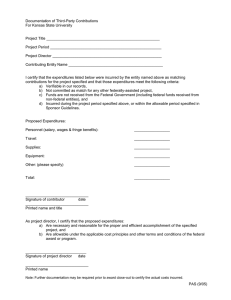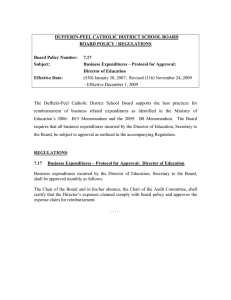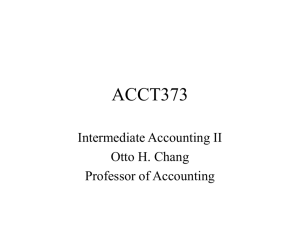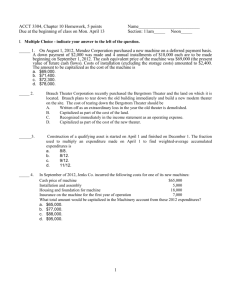BRANDEIS UNIVERSITY POLICY
advertisement
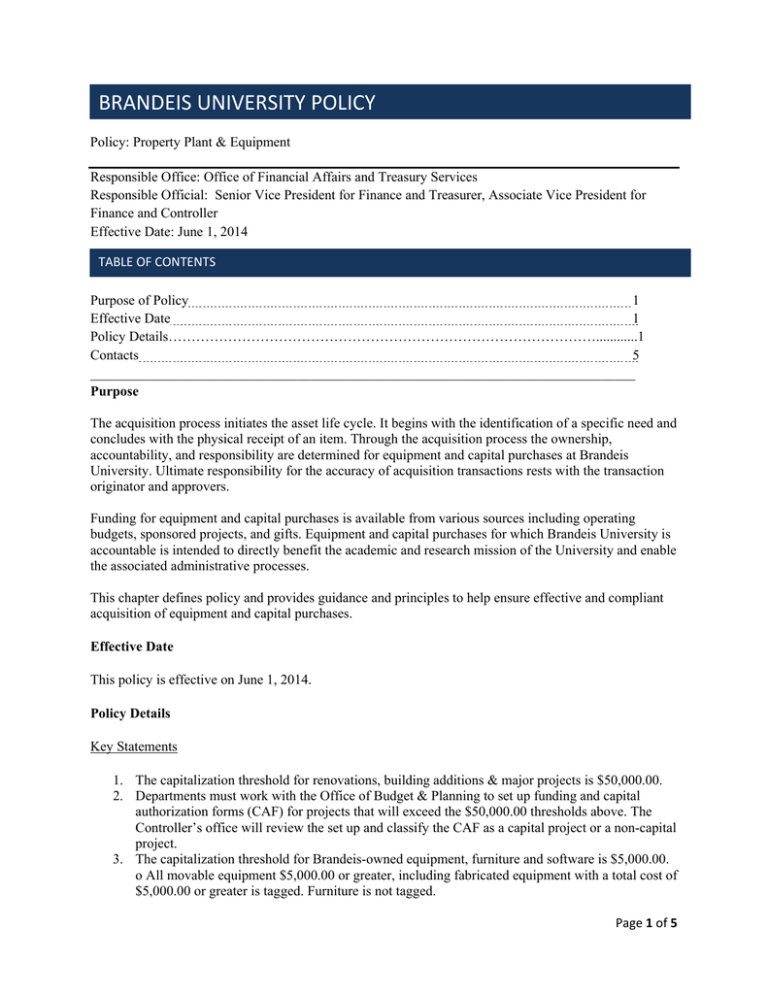
BRANDEIS UNIVERSITY POLICY Policy: Property Plant & Equipment Responsible Office: Office of Financial Affairs and Treasury Services Responsible Official: Senior Vice President for Finance and Treasurer, Associate Vice President for Finance and Controller Effective Date: June 1, 2014 TABLE OF CONTENTS Purpose of Policy 1 Effective Date 1 Policy Details…………………………………………………………………………………............1 Contacts 5 _______________________________________________________________________________ Purpose The acquisition process initiates the asset life cycle. It begins with the identification of a specific need and concludes with the physical receipt of an item. Through the acquisition process the ownership, accountability, and responsibility are determined for equipment and capital purchases at Brandeis University. Ultimate responsibility for the accuracy of acquisition transactions rests with the transaction originator and approvers. Funding for equipment and capital purchases is available from various sources including operating budgets, sponsored projects, and gifts. Equipment and capital purchases for which Brandeis University is accountable is intended to directly benefit the academic and research mission of the University and enable the associated administrative processes. This chapter defines policy and provides guidance and principles to help ensure effective and compliant acquisition of equipment and capital purchases. Effective Date This policy is effective on June 1, 2014. Policy Details Key Statements 1. The capitalization threshold for renovations, building additions & major projects is $50,000.00. 2. Departments must work with the Office of Budget & Planning to set up funding and capital authorization forms (CAF) for projects that will exceed the $50,000.00 thresholds above. The Controller’s office will review the set up and classify the CAF as a capital project or a non-capital project. 3. The capitalization threshold for Brandeis-owned equipment, furniture and software is $5,000.00. o All movable equipment $5,000.00 or greater, including fabricated equipment with a total cost of $5,000.00 or greater is tagged. Furniture is not tagged. Page 1 of 5 4. For projects that have been identified as “non-capital” projects, movable equipment that equals or exceeds $5,000.00 will be capitalized and tagged. 5. Responsibility for accurately coding acquisition transactions for equipment and approving funding sources rests with the originator and the approvers. When equipment is fabricated or multiple equipment purchases will be affixed to each other, it is an imperative responsibility of the originator to initiate communication with the Controller’s office to ensure the expenditures are appropriately recorded. 6. Title to equipment vests with either the University or with the project sponsor only. 7. Title to gifted or donated equipment vests with the University. 8. Accountability for Brandeis-owned equipment resides with the Department. 9. Accountability for equipment on Sponsored Projects resides with the Principal Investigator (PI). 10. The acquiring organization must screen for available items to minimize duplicative acquisitions. Capitalization of Capital Projects All University property, plant and equipment associated with capital projects are discussed below. If the Controller’s office classifies a CAF as capital, all appropriate expenditures related to the CAF will ultimately be capitalized as construction in progress to account 1940 or as movable equipment to account 1960. As expenditures are incurred for capital projects, all project costs should be charged to the 81XX series of accounts, subject to the criteria listed below under “Criteria for capitalizing costs”. Only direct costs that are necessary and relevant to a project should be charged to the project. As expenditures are incurred, the Controller’s office monitors the expenditures in accordance with the criteria outlined below. No depreciation is applied to land or construction in progress. When a capital project is complete: 1. Upon completion, the project manager (or in cooperation with the department) will complete a Project Closeout Form. This form notifies the Controller’s office and the Office of Budget and Planning that the project is complete and ready to be placed in service. 2. After completion of the project, the CAF will remain open for six months as punch list items are resolved. The Office of Budget and Planning is responsible for closing CAF’s once the six month period lapses. Any expenditures related to the project that are incurred after the CAF has been closed need to be examined individually to determine whether they are capitalizable or whether they should be expensed as maintenance. 3. The Controller’s office capitalizes the project as of the date of occupancy (or final date of completed work for non-building projects) and the capitalized cost is componentized among the following categories: a. 1910PPE Land1920PPE Land Improvements1930PPE Buildings1932PPE Building Systems1934PPE Building Improvements1950PPE Utilities1952PPE Fixed Equipment1954PPE Minor Cap Equipment1960PPE Moveable Equipment1964PPE Software Criteria for capitalizing costs for fixed assets (associated with capital projects) Criteria for Capitalizing Land: Land acquired for speculation is not capitalized. It is recorded as an investment. When land is acquired with a building, an allocation for the value of the land is made to account 1910 and will be associated with the corresponding building number. Costs to be capitalized include all costs connected with acquisition. Criteria for Capitalizing Land Improvements: Page 2 of 5 When expenditures are incurred for improvements to the land, other than buildings or infrastructure, that ready the land for its intended use. Examples are site excavations, retaining walls, parking lots, sidewalks, fencing, and landscaping. Criteria for Capitalizing New Buildings: All new construction buildings are capital. Costs to be capitalized include, but are not limited to professional services, materials, labor, and capitalized interest costs and debt origination costs. Criteria for Capitalizing Building Systems: When expenditures are incurred for significant improvements to interior building systems such as HVAC. Criteria for Capitalizing Building Improvements (including renovations and building additions): A renovation or building addition is capital when it enhances the use of, or extends the life of the building if the capitalizable amount equals or exceeds $50,000.00. o Definitions: Enhance the efficiency of a building or portion thereof would be improved, or Extends the useful life of the building beyond its original estimated useful life. Capitalizable amount is the total cost of a renovation project, including any work required on the existing building, less movable equipment equal to or greater than $5,000.00 which will be recorded separately as movable equipment. Criteria for Capitalizing Utilities: When expenditures are incurred to extend utilities to undeveloped parts of campus or to new buildings. Alterations to existing utilities to accommodate a renovation or building additions should also be capitalized. Criteria for Capitalizing Fixed Equipment: When expenditures are incurred for equipment that is affixed permanently or fastened to a surface of building on campus. Examples of fixed equipment are security systems, carpeting, and fume hoods. Criteria for Capitalizing Minor Cap Equipment: When expenditures are incurred for furniture or other minor equipment that is necessary and relevant to completion of the project. Minor equipment also includes movable equipment less than $5,000.00 that is not required to be tagged. Criteria for Capitalizing Movable Equipment: When expenditures are incurred for movable equipment that equals or exceeds $5,000.00 that is necessary and relevant to completion of the project. Examples of movable equipment are computers, freezers, vehicles, and centrifuges. Criteria for Capitalizing Software: All expenditures for software purchased in conjunction with a capital project is capitalized subject to the following: o Installation, service and licensing if imperative for original use of the software is capitalizable. Additional support purchased for use over the life of the software is not a capitalizable expense and should be expensed to account 7412. Page 3 of 5 Criteria for Non-Capitalizable Expenses: During the course of a capital project, there may be costs incurred that are relevant to the project, but will not truly add value to the asset that will be placed in service. Examples of these items would be lunches and office supplies not specifically related to the project. These types of expenses should be charged to the project using account 8180. Capitalization of Movable Equipment – University Owned (not associated with a capital project) Expenditures for movable equipment are capitalized at the invoiced cost plus applicable transportation and installation charges if they meet the following criteria: Newly acquired item with an individual first cost value of $5,000.00 or more. Rebuilt equipment if the rebuilding project effectively restores to like-new condition and/or significantly extends the item’s useful life or markedly increases the item’s net book value. Generally rebuilds must be $5,000.00 or greater. Are free-standing, usable free of support from other equipment, or meets the requirements in item 4 below. Accessory equipment should be considered as a portion of the first cost of the capital item if it was invoiced at the time of the initial purchase or building phase and is intended to be permanently affixed to the initial capital item. Accessory equipment that was purchased with the intent of using interchangeably with two or more items should be capitalized and recorded as a separate item of equipment subject to the $5,000.00 threshold. Fabricated equipment if the total cost of the fabricated equipment will exceed $5,000.00. Are durable (an economic life of more than five years) Definitions of non-capital movable equipment expenditures: Expenditures for repair, maintenance or replacement of component parts which do not extend the unit’s original life or significantly enhance its net value. Expenditures incurred in demolishing or dismantling equipment including those expenditures related to the replacement of units or systems. Expenditures incurred in connection with the rearrangement, transfer, or moving of equipment from one Brandies location to another, including expenditures incurred in dismantling, transporting, reassembling and reinstalling such items to a new location. Fleet/Bulk purchases Purchases of multiple similar pieces of equipment (performing the same or similar basic function) that otherwise meet the criteria above for capitalization but whose unit cost is below $5,000.00 can be capitalized if the purchase is associated with a capital project at the discretion of the Controller’s office. Capitalization of Movable Equipment – Non-University Owned (not associated with a capital project) Expenditures for movable equipment that are non-University owned are NOT capitalized. However, each expenditure is subject to the criteria outlined above for University owned movable equipment. Expenditures are tracked at the invoiced cost plus applicable transportation and installation charges and are subject to tagging and physical inventory. Brandeis performs a physical inventory of capital equipment purchased with federal funds once every two years. Physical inventory records are maintained and reconciled to equipment records. A physical inventory contains description of equipment along with unique identification number, manufacturer’s serial number, model number, source of the equipment, the award number, acquisition date, location and Page 4 of 5 condition of the equipment, disposal date (if applicable), and unit acquisition cost which assist to provide an appropriate system used to safeguard equipment and ensure equipment is adequately maintained. It is the responsibility of the Department and/or PI to communicate with the Office of Financial Affairs immediately when they begin to fabricate equipment or when multiple movable equipment items will be affixed to each other. Software (not associated with a capital project) Expenditures for software are capitalized at the invoiced cost plus any applicable transportation and initial charges if they meet the following criteria: Newly acquired item with an individual first cost value of $5,000.00 or more. An economic life of more than five years Installation, service and licensing if imperative for original use of the software. Additional support purchased for use over the life of the software is not a capitalizable expense and should be expensed to account 7412. Amount To Be Capitalized The cost values to be capitalized as the first cost of an item are outlined below: The vendor’s invoice price for the item less any discounts: in the case of donated items, an appraisal of the item’s current value is used in lieu of an actual invoice price. Original incoming transportation incurred on shipments from external suppliers. For depreciation purposes, all charges of this nature are recorded as having been incurred at the same time as the related items were purchased. The cost of assembly, installation, etc. related to the capitalized item. In the event outside contractors perform the work, the actual price billed for such work is capitalized. If University personnel perform the work, the capitalized cost may include labor and fringe. Contacts If you have any questions about this policy or need more information, please contact the Office of Financial Affairs and Treasury Services ext. 6-8317. Page 5 of 5
